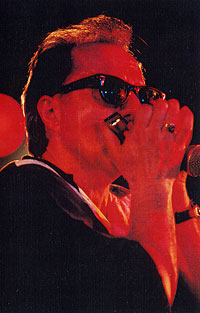 This is part two of "how a record is made." Part one was an interview with John Keefe of
First Generation Recording Studio (see link at bottom of page), where he talked about the technical side of making a record. What follows here is an interview with Pat Hayes of the Lamont Cranston Blues Band who is producing a new live recording of the band.
This is part two of "how a record is made." Part one was an interview with John Keefe of
First Generation Recording Studio (see link at bottom of page), where he talked about the technical side of making a record. What follows here is an interview with Pat Hayes of the Lamont Cranston Blues Band who is producing a new live recording of the band.
There is a sad footnote to this interview-Rick O'Dell, the saxophone player with the Lamont Cranston Blues Band, died unexpectedly early Saturday morning, July 14, 2001. Rick's last performance was the night before in Mankato where he was doing what he loved to do, play music. Please see the links following this interview for some pictures from Rick's last show.
Ray: What prompted you to do a new recording (besides Rico's urgings)?
Pat: It was time to capture this era of the band, especially with Ted Larsen's great guitar playing.
Ray: Have you been writing new material?
Pat: Yes, I'm always writing new material.
Ray: Why a live CD as opposed to a new studio album?
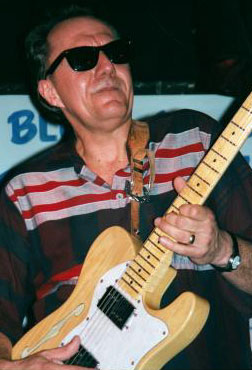 Pat: A lot of people have been asking for a live recording. They say we sound better live than in the studio. I know we have more energy live.
Pat: A lot of people have been asking for a live recording. They say we sound better live than in the studio. I know we have more energy live.
Ray: What kinds of preparations do you make when you know you are going to record a live show?
Pat: We just make sure we have our show down and we all know the tunes real well.
Ray: How did those two shows go (at Whiskey and Brewbaker's) where you had the live recordings for this project?
Pat: The shows went great, we had big crowds with a lot of cheering from the people.
Ray: Once the recording is done, what comes next?
Pat: Then we press a bunch up and get them out to stores and sell them at our shows.
Ray: In your role as producer, what exactly do you do? Since I am not a musician, please explain in detail what you are listening for and trying to achieve?
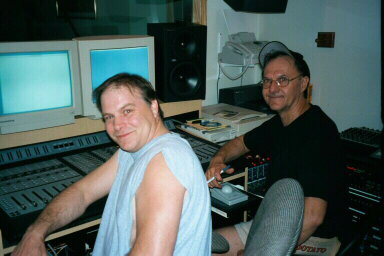 Pat: The producer oversees the project from start to finish. Sometimes he'll put together the financing. He picks the tunes and fashions the sound in the mix. I am trying to get the recording on this one as close to our live sound as we can get it.
Pat: The producer oversees the project from start to finish. Sometimes he'll put together the financing. He picks the tunes and fashions the sound in the mix. I am trying to get the recording on this one as close to our live sound as we can get it.
Ray: How important is the role of producer in the final product of a live recording?
Pat: The producer's role is very important, because he controls the whole project.
Ray: What is the difference in the producer's role with this live recording vs. a studio recording?
Pat: In a live recording there is very little over dubbing, if any at all. So the producer just uses the music that was cut live. In a studio recording there is usually a lot more control over arrangements and solos.
Ray: How did you settle on the length (double CD vs. single) of the CD and what songs to include?
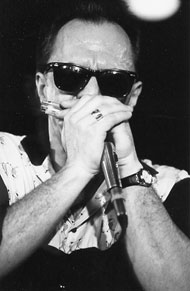 Pat: We thought there were too many good songs to leave out if we did only a single CD. We decide what songs to include by how well they were played and if they are crowd favorites.
Pat: We thought there were too many good songs to leave out if we did only a single CD. We decide what songs to include by how well they were played and if they are crowd favorites.
Ray: When will you start on your next studio recording?
Pat: We hope to do a new studio album this winter.
Ray: You recently performed solo at a show in St. Peter. How did that come about?
Pat: I sometimes do a couple of tunes by myself during Cranston shows and I did that at the Blue Moon in Kasota and Gary Campbell saw it and liked it, so he got the idea to have me do a solo show at the St. Peter Art Center and I said well, I might as well try it and see what happens.
Ray: What was that experience like for you? It is quite a bit different than playing with your band.
Pat: Well, I was a little nervous at first, but then people were applauding and I knew they liked it, so I loosened up and had a great time. It's different than with the band because it's a lot quieter and I have more freedom to change the songs around because nobody has to follow me. And it's easier to sing at the lower volume.
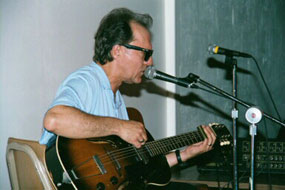 Ray: Would you like to do it again?
Ray: Would you like to do it again?
Pat: Yes, I would and I'm looking into venues to play at.
Ray: What would you do differently? What would you do the same?
Pat: I would have more tunes ready, because when I did it, I thought 10 tunes would take up an hour, really it was more like 15. So I did stuff on the spot that I didn't plan on doing. As far as doing it the same, I would keep the stories in between songs.
Ray: How long have you been playing music?
Pat: Since about '65.
Ray: What got you interested in the blues?
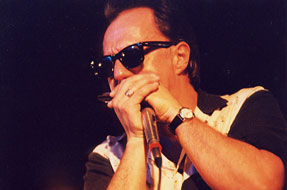 Pat: It was in my blood I guess. I think some people just have an afinity for it and some don't. I was one of those who had that feeling for blues before I even knew what it was. Remember, I was 9 years old in '59 so I heard Fats Domino and Little Richard on the top 40 radio then, and that music was real bluesy. I didn't know what it was, but the bluesy stuff really got to me. Then, the English bands sent it back across the ocean and of course I loved it then, but then I found out these bands were imitating American blues men, so I started to buy all the blues records I could afford and entered this great world of music.
Pat: It was in my blood I guess. I think some people just have an afinity for it and some don't. I was one of those who had that feeling for blues before I even knew what it was. Remember, I was 9 years old in '59 so I heard Fats Domino and Little Richard on the top 40 radio then, and that music was real bluesy. I didn't know what it was, but the bluesy stuff really got to me. Then, the English bands sent it back across the ocean and of course I loved it then, but then I found out these bands were imitating American blues men, so I started to buy all the blues records I could afford and entered this great world of music.
Ray: How did you first take up the harmonica and who were your major or important influences?
Pat: We had a little garage band going called "The Moon". Rico Anderson on drums, my brother Larry on guitar, me on vocals and Tim Howe on bass and we were doing Stones and Yardbirds type stuff and my brother said the cool thing for singers to do is play harmonica. So, I picked one up and started to play it like Brian Jones and Dylan. But, then I happened to hear an early release of "Born In Chicago" by Paul Butterfield, I didn't even know it was a harp because I'd never heard electric harp before. But, the sound of it really intrigued me, my brother said "that's harmonica through an amplifier." So, I went and got an amp for my harp. It was right after that I discovered all the great blues harp players; Little Walter, Sonny Boy Williamson, James Cotton, Walter Horton, Slim Harpo and Jimmy Reed. And, don't forget Howlin' Wolf.
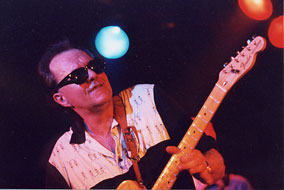 Ray: Was it a hard instrument to learn? How did you learn to play it?
Ray: Was it a hard instrument to learn? How did you learn to play it?
Pat: No, it was easy for me. It took some time before I was any good, but I had fun learning.
Ray: When did you start playing guitar?
Pat: I started playing it in about '67 just picking around the house for fun, and I got to where I could kind of get around on it. Then we went to the mountains to play and I wasn't used to the thin air and there was no way I could do more then 3 songs on the harp in a row, so I just headed over and grabbed my guitar and started to play the next few songs on guitar, much to the dismay of my band members.
Ray: When did you form the Lamont Cranston Blues Band and who were the original members?
Pat: We formed in 1969, Joe Scheroman on bass, Danny Webb on drums, Dave Olausen on guitar and me on harp and vocals.
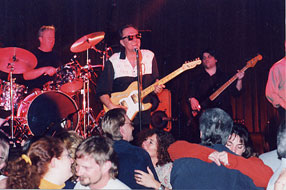 Ray: Has your brother played with you all along too?
Ray: Has your brother played with you all along too?
Pat: No, he came in later, about 1970.
Ray: How has the blues scene, specifically, and the music scene in general, changed over these past 30 years?
Pat: The music scene is way bigger now with much more choices for music fans, it's all broken down into different categories; Hip Hop, Trip Hop, Swing, Western Swing, Club, Retro, Acid Rock, and it goes on and on. Back when we started it was much simpler and not as much of it. It seems like there's more of everything these days. As far as the blues scene goes, back when we started there were only a couple places a blues band could play, The Triangle and The Joint and there were maybe 3 blues bands in the Twin Cities. Now, you know there is lots of clubs to play and lots of blues bands playing them.
Ray: I remember first seeing you perform at the Cabooze on the West Bank back in the early 70's. What were some of the other clubs you played at during that time and what were they like?
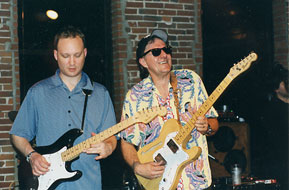 Pat: In the 70's, we started to play the River Serpent in St. Paul and the St. Croix Boom Company in Stillwater and the Red Carpet in St. Cloud and we started to tour to support our first recordings. All of the clubs I just mentioned were a lot of fun.
Pat: In the 70's, we started to play the River Serpent in St. Paul and the St. Croix Boom Company in Stillwater and the Red Carpet in St. Cloud and we started to tour to support our first recordings. All of the clubs I just mentioned were a lot of fun.
Ray: You have played with many of the blues legends. What are some of your best memories performing with some of these guys and gals?
Pat: When we played with Muddy Waters at the River Serpent, he was leaving at about 3 in the morning with Pinetop and a couple of members of his band. I was watching them from the veranda, they were in the parking lot, Muddy didn't know I was watching or he never would have done it, but he let out the most spine chilling wolf howl I've ever heard directed at the full moon that was glistening on the Mississippi that warm summer night. I will never forget that night.
Also, when Albert King let me trade licks with him onstage in New York, plus a lot of informal jams at different houses. A lot of which were at Lazy Bill's house off Lake Street. And, one night at my house I had Carey Bell and Kim Wilson on harps and me and Larry on guitars and it sounded so good !
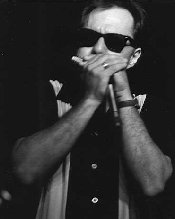 Ray: How did that Rolling Stones tour come about? Any interesting stories surrounding that?
Ray: How did that Rolling Stones tour come about? Any interesting stories surrounding that?
Pat: Our management team at the time were also the promoters of the Stones show, so they sent Bill Graham a copy of Shakedown and asked if we could open the show. They turned us down at first, but then the Stray Cats cancelled their opening spot in St. Louis the morning of the show, I think they wanted a raise, Bill Graham put in the cassette of us, played it and liked it. He called our management and put us on three shows starting that night. We just had 24 inches of snow and had quite a time getting to the airport, but we all made it, except Jim Greenwell, who got there just after we got done playing. Our equipment got lost on the plane, so the Stones let us use theirs. Those amps and the P.A. sounded so good. I had a ball just playing on that stuff right and less of what the crowd thought of us. Well it turned out they liked us enough not to boo us off stage, which is what happened to most of the bands on that tour that opened for the Stones. To me it was just a big party with 55,000 people. We did all three nights and had a great time.
Ray: How about the Bonnie Raitt tour, how did that come about and what was that like?
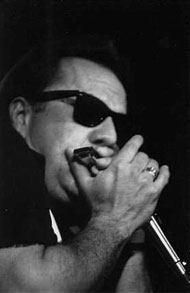 Pat: We met Bonnie through her brother Steve who worked for us in the mid 70's. He played our records for her and she liked us, so we did some shows with her around the country. I would always get up and play harp with her, so when she won all those Grammys in 1990, she figured she could afford to take me on the road with her, I went of course and was playing every night to crowds of about 20,000 all over the U.S. We had a great show and really good sound. Also, Charles Brown was opening and riding on the tour bus. What a pleasure listening to all the stories he told as we drove to the next town, and he played great.
Pat: We met Bonnie through her brother Steve who worked for us in the mid 70's. He played our records for her and she liked us, so we did some shows with her around the country. I would always get up and play harp with her, so when she won all those Grammys in 1990, she figured she could afford to take me on the road with her, I went of course and was playing every night to crowds of about 20,000 all over the U.S. We had a great show and really good sound. Also, Charles Brown was opening and riding on the tour bus. What a pleasure listening to all the stories he told as we drove to the next town, and he played great.
Ray: Here's an interesting question that has spawned many debates. Can a white guy play the blues?
Pat: Yes, I believe white guys can play the blues. I believe the blues has no color. And I think most of the top bluesmen would agree with me. A question like this requires a long answer so I hope you don't mind. Remember that the blues was born when the melodic European music met the percussive beat oriented music of Africa and the islands. Most of our early blues heroes were imitating something handed down to them. When records got the music out to more people they began to learn from them. Muddy was influenced by Robert Johnson and Son House, Wolf was influenced by Charlie Patton and others. When Johnny Otis came along in the 40's, he played in all black bands, lived in the neighborhood and so totally absorbed that culture that people couldn't believe he was white. Anyone who says Johnny Otis can't play the blues is just dead wrong. Also Jerry Mulligan plays great blues. And what about Steve Cropper and Duck Dunn? How many black players have been influenced then by Robert Cray? The blues is always changing and assimilating influences. It's just that some people want it to stay the same. Well, there's lots of different styles of blues all the way from the lowdown delta to the uptown Ray Charles, all of it great music. But, to assume one style is better than another is not right. Some people like to put other people down, thinking that makes them look better, really all they're doing is limiting their blues appreciation to just the style they think is real blues, it's kind of sad really.
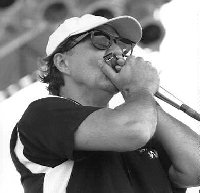 Ray: What is your opinion of the younger blues guitar slingers that seems to spark hot debates?
Ray: What is your opinion of the younger blues guitar slingers that seems to spark hot debates?
Pat: I think a lot of them were first influenced by Stevie Ray and never went beyond that. The ones that study the great masters; T-Bone, Freddy, B.B., Otis, etc. turn out to be better guitarists because they learn a larger vocabulary of expression. Also, there comes a point when it's no longer blues, I think most of us know when it turns into Rock, now I'm not saying that's bad, I do it myself, I'm just saying it's not blues any more. And they don't belong in things like the Handy Awards and the Minnesota Music Awards blues band category. Because bands like George Jackson, who deserve to win, lose out.
Ray: What is your connection to Dan "Elwood Blues" Aykroyd? And what's that rumor about the Blues Mobile sitting out at your place?
Pat: I used to live with Tom Davis and Al Franken before they moved to New York to write for Saturday Night Live. They brought our music to Aykroyd and Belushi who met us at the "Other End" in New York. We got along great and they would give us little plugs every now and then. That's what Elwood was doing when he said I had the Blues Mobile, he was just giving me a little plug, and I think that was very nice of him.
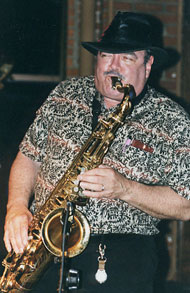 Ray: What's in store for The Lamont Cranston Blues Band during this next year?
Ray: What's in store for The Lamont Cranston Blues Band during this next year?
Pat: We'll just keep playing and learning the best we can.
Ray: Please feel free to add or comment on anything else.
Pat: As you know by now, we just lost a very important part of our little Cranston family, our sax player Rick O'Dell, who died of a heart attack on the morning of July 14th. Those of you who saw us play that night at Whiskey Junction might have noticed all the black outfits on stage and the sort of dazed and shocked band. Rick was in my band on and off for 22 years. He was not only a great sax player, but he was a great person. He always knew how to cheer us up with his great sense of humor and wild antics on stage. He never joked at the expense of others, usually it was him at the brunt of the jokes. I loved this man and so did the other members of the band. Although it is very hard to get used to the fact he's not around anymore, we consider ourselves lucky that we were able to play music with him and to know him as a friend. May he live on in his music.
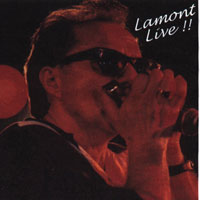 PRESS RELEASE
PRESS RELEASE
JULY 24, 2001
THE LAMONT CRANSTON BLUES BAND RELEASES NEW DOUBLE LIVE CD
The Lamont Cranston Blues Band is back with a vengeance. Four years after the release of the band's critically acclaimed CD, "Roll With Me", the band is at it again. This time around they've chosen to hit their fans with a double whammy. "Lamont Live !!" was recorded live in April, 2001 at Whiskey Junction and Brewbaker's, this double disc set is packed with 19 tracks, including all the Cranston favorites; Upper Mississippi Shakedown, E Jam, What A Party, Roll With Me, Streets Around Here, Lickin' Stick and more.
The band has talked about doing a live CD for quite awhile now, and it's finally here.
Only the Cranston's could tackle the unique idea of a double live set. "We went back and forth, but there was just too much great material to limit it to one disc," says Lamont Cranston manager Rico Anderson, "listening to the discs will be like spending a night out with the band without even leaving the house."
The new live CD set captures the last recordings of saxophonist Rick O'Dell, who passed away July 14th at his home in St. Paul. A release date is set for Tuesday, August 7th.
Band members:
Pat Hayes - Harp, Guitar, Vocals
Ted Larsen - Guitar
Michael Carvale - Bass, Upright Bass
Jim Novak - Drums
Dale Peterson - Piano, Hammond B3
Jim Greenwell - Saxophone
Rick O'Dell - Saxophone
 CLICK HERE for pictures of the Lamont Cranston Blues Band!
CLICK HERE for pictures of the Lamont Cranston Blues Band!
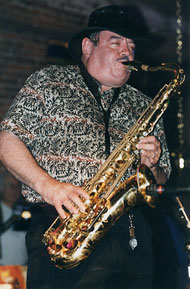 PRESS RELEASE
PRESS RELEASE
JULY 24, 2001
BENEFIT & TRIBUTE FOR LAMONT CRANSTON SAXOPHONIST RICK O'DELL
A benefit and tribute show is planned for Tuesday, August 7th to help raise funds to
cover expenses for the late Lamont Cranston Blues Band saxophonist Rick O'Dell, who passed away July 14th of a heart attack at the age of 55. O'Dell, who spent much of his career with Lamont Cranston, also played with Michael's Mystics, Doug Maynard, Raggs, Big Walter Smith, The Swinging Ambassadors and many more.
The benefit show will be held at the Minnesota Music Cafe, 7th & Payne, St. Paul. Acts confirmed at press time include; Joel Johnson, Paul Metsa, Big Walter Smith, Raggs, TC Jammers, Mick Sterling and The Lamont Cranston Blues Band with special guests Bruce McCabe and Charlie Bingham, plus many more surprise guests. Show starts 6:00 p.m. Tickets $10.00. Call the Minnesota Music Cafe for more information at 651-776-4699.
"A Picture is worth a thousand words, but a song is worth a thousand pictures."
--Rick O'Dell
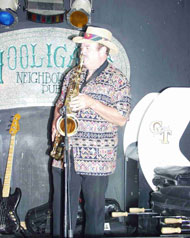 CLICK HERE (www.gtojon.com/rick) for pictures from Rick O'Dell's last performance by Jon Smithers
CLICK HERE (www.gtojon.com/rick) for pictures from Rick O'Dell's last performance by Jon Smithers
Lamont Cranston Blues Band website: http://ourworld.compuserve.com/homepages/lamontcranston/
Email: Rico1@aol.com
Other two parts of the making of a record series:
This review is copyright © 2001 by Ray Stiles, and Blues On Stage, all rights reserved. Copy, duplication or download prohibited without written permission. For permission to use this review please send an E-mail to Ray Stiles.
